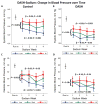Time Course of Change in Blood Pressure From Sodium Reduction and the DASH Diet
- PMID: 28993451
- PMCID: PMC5659740
- DOI: 10.1161/HYPERTENSIONAHA.117.10017
Time Course of Change in Blood Pressure From Sodium Reduction and the DASH Diet
Abstract
Both sodium reduction and the Dietary Approaches to Stop Hypertension (DASH) diet lower blood pressure (BP); however, the patterns of their effects on BP over time are unknown. In the DASH-Sodium trial, adults with pre-/stage 1 hypertension, not using antihypertensive medications, were randomly assigned to either a typical American diet (control) or DASH. Within their assigned diet, participants randomly ate each of 3 sodium levels (50, 100, and 150 mmol/d, at 2100 kcal) over 4-week periods. BP was measured weekly for 12 weeks; 412 participants enrolled (57% women; 57% black; mean age, 48 years; mean systolic BP [SBP]/diastolic BP [DBP], 135/86 mm Hg). For those assigned control, there was no change in SBP/DBP between weeks 1 and 4 on the high-sodium diet (weekly change, -0.04/0.06 mm Hg/week) versus a progressive decline in BP on the low-sodium diet (-0.94/-0.70 mm Hg/week; P interactions between time and sodium <0.001 for SBP and DBP). For those assigned DASH, SBP/DBP changed -0.60/-0.16 mm Hg/week on the high- versus -0.42/-0.54 mm Hg/week on the low-sodium diet (P interactions between time and sodium=0.56 for SBP and 0.10 for DBP). When comparing DASH to control, DASH changed SBP/DBP by -4.36/-1.07 mm Hg after 1 week, which accounted for most of the effect observed, with no significant difference in weekly rates of change for either SBP (P interaction=0.97) or DBP (P interaction=0.70). In the context of a typical American diet, a low-sodium diet reduced BP without plateau, suggesting that the full effects of sodium reduction are not completely achieved by 4 weeks. In contrast, compared with control, DASH lowers BP within a week without further effect thereafter.
Clinical trial registration: URL: http://www.clinicaltrials.gov. Unique identifier: NCT00000608.
Keywords: antihypertensive agents; blood pressure; diet; hypertension; sodium.
© 2017 American Heart Association, Inc.
Conflict of interest statement
The authors have no conflicts of interest to report.
Figures


Comment in
-
Background Dietary Patterns and the Time Course of the Blood Pressure Response to Low Sodium Intake.Hypertension. 2017 Nov;70(5):890-892. doi: 10.1161/HYPERTENSIONAHA.117.10129. Hypertension. 2017. PMID: 28993447 No abstract available.
Similar articles
-
Effects of Sodium Reduction and the DASH Diet in Relation to Baseline Blood Pressure.J Am Coll Cardiol. 2017 Dec 12;70(23):2841-2848. doi: 10.1016/j.jacc.2017.10.011. Epub 2017 Nov 12. J Am Coll Cardiol. 2017. PMID: 29141784 Free PMC article. Clinical Trial.
-
Low-sodium Dietary Approaches to Stop Hypertension-type diet including lean red meat lowers blood pressure in postmenopausal women.Nutr Res. 2009 Jan;29(1):8-18. doi: 10.1016/j.nutres.2008.12.002. Nutr Res. 2009. PMID: 19185772 Clinical Trial.
-
One-year follow-up study of blood pressure and dietary patterns in dietary approaches to stop hypertension (DASH)-sodium participants.Am J Hypertens. 2004 Dec;17(12 Pt 1):1156-62. doi: 10.1016/j.amjhyper.2004.07.005. Am J Hypertens. 2004. PMID: 15607623
-
Dietary Approaches to Stop Hypertension (DASH) Diet and Blood Pressure Reduction in Adults with and without Hypertension: A Systematic Review and Meta-Analysis of Randomized Controlled Trials.Adv Nutr. 2020 Sep 1;11(5):1150-1160. doi: 10.1093/advances/nmaa041. Adv Nutr. 2020. PMID: 32330233 Free PMC article.
-
Overview of salt restriction in the Dietary Approaches to Stop Hypertension (DASH) and the Mediterranean diet for blood pressure reduction.Rev Cardiovasc Med. 2022 Jan 19;23(1):36. doi: 10.31083/j.rcm2301036. Rev Cardiovasc Med. 2022. PMID: 35092228 Review.
Cited by
-
Risk factors of the progression to hypertension and characteristics of natural history during progression: A national cohort study.PLoS One. 2020 Mar 17;15(3):e0230538. doi: 10.1371/journal.pone.0230538. eCollection 2020. PLoS One. 2020. PMID: 32182265 Free PMC article.
-
Daily sodium intake influences the relationship between angiotensin-converting enzyme gene insertion/deletion polymorphism and hypertension in older adults.J Clin Hypertens (Greenwich). 2018 Mar;20(3):541-550. doi: 10.1111/jch.13224. Epub 2018 Mar 9. J Clin Hypertens (Greenwich). 2018. PMID: 29521003 Free PMC article.
-
Rationale and Design of the Groceries for Black Residents of Boston to Stop Hypertension Among Adults Without Treated Hypertension (GoFresh) Trial.Am J Hypertens. 2023 Apr 15;36(5):256-263. doi: 10.1093/ajh/hpad008. Am J Hypertens. 2023. PMID: 37061794 Free PMC article. Clinical Trial.
-
Effects of the Chinese heart-healthy diet (Sichuan cuisine) on lowering blood pressure in adults with hypertension: a randomized controlled feeding trial.Asia Pac J Clin Nutr. 2024 Mar;33(1):11-22. doi: 10.6133/apjcn.202403_33(1).0002. Asia Pac J Clin Nutr. 2024. PMID: 38494683 Free PMC article. Clinical Trial.
-
Exploring experiences and perspectives of patients on hypertension management in Southern Ethiopia: a phenomenological study.BMC Health Serv Res. 2024 Dec 19;24(1):1625. doi: 10.1186/s12913-024-12111-8. BMC Health Serv Res. 2024. PMID: 39702319 Free PMC article.
References
-
- Sacks FM, Svetkey LP, Vollmer WM, Appel LJ, Bray GA, Harsha D, Obarzanek E, Conlin PR, Miller ER, Simons-Morton DG, Karanja N, Lin PH DASH-Sodium Collaborative Research Group. Effects on blood pressure of reduced dietary sodium and the Dietary Approaches to Stop Hypertension (DASH) diet. DASH-Sodium Collaborative Research Group. N Engl J Med. 2001;344:3–10. - PubMed
-
- He FJ, MacGregor GA. Importance of salt in determining blood pressure in children: meta-analysis of controlled trials. Hypertension. 2006;48:861–869. - PubMed
-
- Mozaffarian D, Fahimi S, Singh GM, Micha R, Khatibzadeh S, Engell RE, Lim S, Danaei G, Ezzati M, Powles J Global Burden of Diseases Nutrition and Chronic Diseases Expert Group. Global sodium consumption and death from cardiovascular causes. N Engl J Med. 2014;371:624–634. - PubMed
-
- Appel LJ, Moore TJ, Obarzanek E, Vollmer WM, Svetkey LP, Sacks FM, Bray GA, Vogt TM, Cutler JA, Windhauser MM, Lin PH, Karanja N. A clinical trial of the effects of dietary patterns on blood pressure. DASH Collaborative Research Group. N Engl J Med. 1997;336:1117–1124. - PubMed
-
- Conlin PR, Chow D, Miller ER, Svetkey LP, Lin PH, Harsha DW, Moore TJ, Sacks FM, Appel LJ. The effect of dietary patterns on blood pressure control in hypertensive patients: results from the Dietary Approaches to Stop Hypertension (DASH) trial. Am J Hypertens. 2000;13:949–955. - PubMed
Publication types
MeSH terms
Substances
Associated data
Grants and funding
LinkOut - more resources
Full Text Sources
Other Literature Sources
Medical
Research Materials

